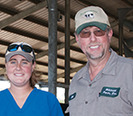Here at the farm, we have tried hard to stay up to date. It seems that if you get stuck in the old way of doing things, you begin to fall behind. New technology helps us discover things that we wouldn’t normally have been able to do or see. One of those is milk culturing for mastitis detection.
Before, we would take a sample from a cow with noticeable mastitis, treat her, send the sample when we had five to 10 samples ready to be shipped, and get the results back within a month. But honestly, what good does that do to get results back from a cow you treated a month or so ago?
We used it to see if we had any cows that came back with Staphylococcus aureus, which was rare, but it did happen from time to time. We would then put them on the next week’s cull list. The problem with this was that for the month to two months we were waiting for a result to come back, the staph-infected cow would go back into the herd after treatment and have the ability to spread her infection for a whole month to two. This could be a disaster waiting to happen.
We played around with the idea of doing the milk plating ourselves. It sounded like a laboratory nightmare at first: incubating petri dishes, studying results, and collecting data. I was a little intimidated at the thought of it all. But, when I found out I could have results within 24 to 48 hours, I wanted to learn more about it.

We bought a small egg incubator and placed it in an old office on the farm. We put a small refrigerator and some storage containers in there to keep everything organized. We had some petri dishes shipped and put them in fridge, so they were ready to go, along with a manual on how to read all the information we were collecting from the dishes.
This opened up a whole new experience for us. We can tell gram positive from gram negative mastitis. We can see new growth and no growth. What I love to see is if a cow has mastitis, I plate it and it doesn’t grow. This means she has effectively killed it off herself and we do not have to spend the money or effort on treatment. Also, it has definitely saved us from spreading Staph. aureus.
I would highly recommend on-farm culturing to all dairy farmers. It’s a little bit intimidating at first, but after you do it once or twice and really study the information the manual gives you, it is pretty easy to determine what types of mastitis you have and also if they even need to be treated.

Mark and Caitlin Rodgers are dairy farmers in Dearing, Georgia. The Rodgers have a 400-cow dairy that averages 32,000 pounds of milk. Follow their family farm on Facebook at Hillcrest Farms Inc.










